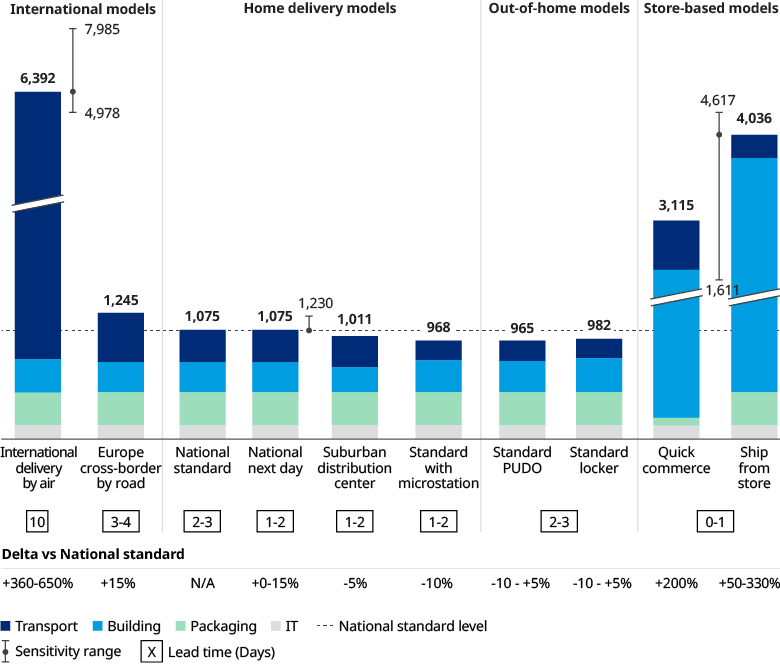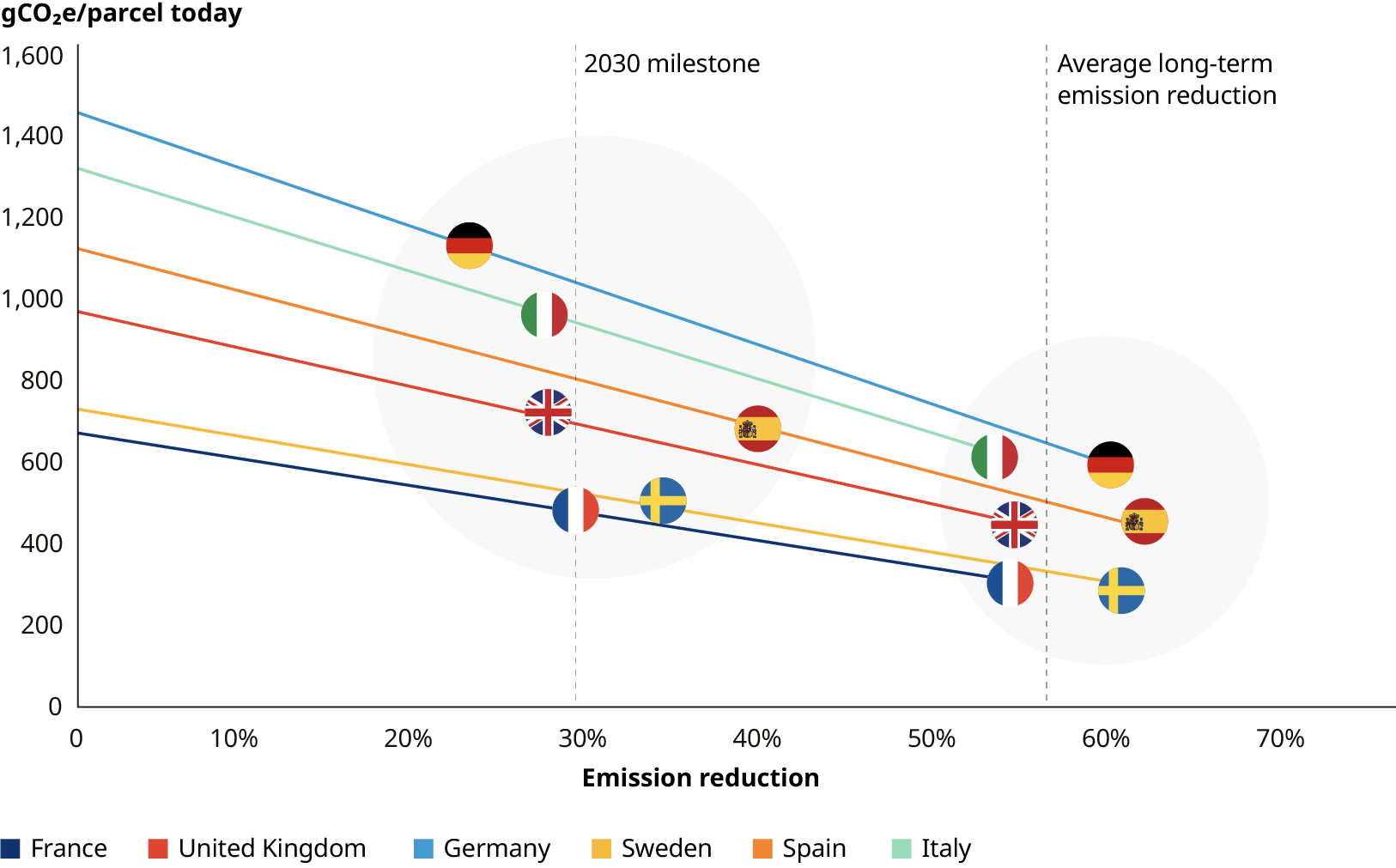The breadth of products offered through e-commerce has expanded, and more categories are now available online, from a greater number of vendors around the globe. Online and offline shopping are more closely integrated, and second-hand goods are increasingly popular. More delivery options are available, and related services — such as tracking and rerouting — are becoming standard.
This growing diversity offers customers more opportunity and choice to find what they want. But it also makes it increasingly difficult for both shoppers and retailers to understand the environmental impact of online purchases — and, more specifically, of delivery.
Our previous study of e-commerce, published in 2021, highlighted that in Europe, the environmental impact of e-commerce is positive: Online shopping in Europe generates an average of between 1.5 and 2.9 times less greenhouse gas (GHG) emissions than offline shopping. The study also demonstrated that emissions from both types of shopping vary significantly by product type, country, and — more importantly — customers’ locations and purchasing behavior.
The objective of this study is to go to a further level of granularity and focus on delivery emissions — to compare the emissions from various delivery models, to identify the main drivers, and to determine how delivery-related emissions of CO2 equivalent (CO2e) can be further reduced. Does home delivery generate higher emissions than pickup-point delivery (PUDO: pick up, drop off)? Does faster delivery result in higher emissions? How can the best technologies available today help reduce delivery emissions? What would it take to reach a 30% reduction in emissions per parcel by 2030 compared to the 2019 level?
Several major parcel operators have committed to at least matching the EU Green Deal target of being climate-neutral by 2050. Among them, the sustainability leaders are aiming to reach net zero by 2040, 10 years earlier. Most initiatives address the entire value chain, encompassing renewable energy sourcing and production, carbon-neutral buildings, carbon-neutral packaging, and zero-emissions transport — and complementing these measures with carbon offsetting.
To substantially reduce delivery-related emissions, resources and efforts will need to be focused on the levers with the greatest impact, and multiple complex solutions will have to be navigated. This calls for a comprehensive assessment of the emissions generated by today’s delivery modes and an understanding of possible trajectories to decarbonize these modes.
This new study focuses on six countries, which together account for over 60% of European online sales: France, Germany, Italy, Spain, Sweden, and the United Kingdom. It is based on an analysis of official statistics, our proprietary CO2e impact model, data made public by delivery operators and confirmed through interviews, and consumer surveys conducted in 2022.
Customer standpoint: Faster delivery, more delivery options, more attention to the environment
Beyond prices, consumers are often faced with three major questions when choosing a delivery option: Do they want a parcel delivered to their home – or to a nearby location where they can pick it up? How fast do they want to get their purchase? And what is the environmental impact of the available options?
Home delivery remains the preferred option for receiving an article purchased online in the six countries studied. On average, more than 60% of e-shoppers say they favor it:
Fast delivery (in less than two days) is an important decision factor for 45% of e-shoppers and for up to 72% of frequent buyers. Next-day delivery is offered by 70% of the largest
European e-stores.
87% of all e-shoppers are keen to change their habits if it can reduce their environmental impact. Their preferred actions are, in order: grouping orders (26%), favoring national shipment (16%), walking to a PUDO location (16%), and choosing an environmentally friendly merchant (16%). The least-popular action, preferred by just 13%, is a delayed delivery if it could reduce delivery emissions.
Emissions from delivery models: Scale and country energy mix matter more than speed
Our analysis shows that delivering at home a single, 1 kg parcel through a country’s most common postal system in two days or more generates an average of 1,075 gCO2e, a measure of the global-warming effect of greenhouse gases in terms of the equivalent quantity of carbon dioxide. Different delivery models were compared to understand the key emissions drivers. The results show that the best way to minimize emissions per parcel is not to reduce delivery speed but to optimize last mile delivery and use the largest possible vehicles in the linehaul and maximize their loads.
The second most important factor influencing emissions is the size and location of buildings — hubs, delivery stations, and pickup points. Buildings’ impact can be even greater than that of transportation, especially in countries that depend heavily on fossil fuels to produce electric power, such as Germany and Italy (500 to 600 gCO2e per parcel compared to the average of 300 gCO2e per parcel).
Delivery speed by itself does not drive emissions. When ranking delivery options by lead time for the consumer (the gap between ordering and delivery), emissions form a U-curve: the fastest and slowest options have the highest emissions (see Exhibit 1). The slowest option (international delivery in 10 days or more) has the highest emissions (six times the level of national delivery). National deliveries in one to four days generate emissions ranging between 10% lower and 15% higher than national standard delivery. Same day options can generate emissions up to three or four times higher than national standard.

Decarbonization pathway: 30% reduction by 2030, then 60% reduction at full potential with known technologies
Reaching a 30% reduction in greenhouse gas emissions by 2030 would require action on all sources of emissions, through the generalization of today’s best practices, the deployment of emerging clean motorization technologies, and the improvement of countries’ energy mixes. This 30% goal has been derived from the various targets set by the EU Commission for trucks, vans, packaging, national energy mixes, and other factors.
In the long term, pushing decarbonation drivers to the maximum level technically possible could lead to a reduction in overall emissions of between 55% and 60% to 448 gCO2e. That would leave 40% to 45% remaining before full carbon neutrality is achieved, through new technologies or infrastructure that is even more energy efficient.

This report is the result of an independent study led by Oliver Wyman. It was conducted over a 12-week period and commissioned by Amazon. The methodology has been defined by Oliver Wyman independently of Amazon. The analysis, conclusions, and projections are those of Oliver Wyman only. The analysis is based on official statistics up to 2021 (unless stated otherwise) and publicly available information. The study does not use any private information from Amazon or other retailers or transport operators. Consumer behavior data is based on proprietary surveys conducted by Oliver Wyman in 2022 across Europe (France, Germany, United Kingdom, Sweden, Italy, Spain).
